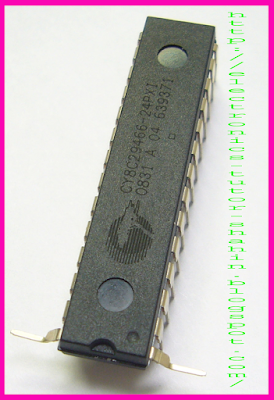What are we doing? Watch This Video First.
IC is a cool little text to speech TTS256 SpeakJet IC chip that is connected to the device and the user text automatically send a text string and sounds are converted to be able to interpret SpeakJet. You can send TTS256 English words aloud and then Speakjet essence of the word; How cool is that! A person of this ourselves,
"code for the costs, however, could have too much; Once you have written the code required to explain in English code space will be left for your own applications. TTS256 is still plenty of room for other things in your project, you can add text to speech.
VIAS bent pins on a slope in the voice box to keep TTS256. Orient so that the curvature of the pins on the chip shield 'Vin' pin is facing. We are one of a solder wire is bent pins, and this will make it easier.
Now that the chip is soldered to the board correctly, the only thing left to add a speaker. I have a 2-pin female header added to the Voice Box Shield and an 8 ohm speaker cable is plugged into them; But if you want the slope of the output terminal to solder directly to the speaker.
IC is a cool little text to speech TTS256 SpeakJet IC chip that is connected to the device and the user text automatically send a text string and sounds are converted to be able to interpret SpeakJet. You can send TTS256 English words aloud and then Speakjet essence of the word; How cool is that! A person of this ourselves,
"code for the costs, however, could have too much; Once you have written the code required to explain in English code space will be left for your own applications. TTS256 is still plenty of room for other things in your project, you can add text to speech.
In this short tutorial, we Voicebox from SparkFun Shield TTS256 to add to the cover, and the device will look sentence for sending a basic sketch.
What do I need?
Hardware:
- Arduino (Duemilanove or Pro 5V)
- IC TTS256
- Voicebox Shield
- Stackable 6-pin header (2)
- Stackable to 8-pin header (2)
- Speaker
- hookup wire
Code:
Basic TTS256 / Arduino sketch interface.
Hardware hook-up!
This is not too much to do to get the project up and running; However, there are a couple of delicate solder connections that have to be made. We'll start with the easy stuff: Voice Box paretabe header onto the slope away from the solder material so that the male connector is pointing down. Now we have to IC TTS256 onto the slope. Shield, prototyping VIAS 13 columns TTS256 14 pins on each side. Bummer! A dirty fix that must be made in order to bend the chip pins 1 and 28 can not be put into the rest of the VIAS. IC Pin 1 is indicated with a small dot. Check it out below.
 |
| TTS256 with bent pins |
 |
| TTS256 inserted onto the Voicebox Shield |
Now the 'delicate' part; TTS256 there has to be attached to the 5 signals. The following table describes the connections that need to be made. 5V, GND and protect TTS256's Rx pin header pin should be connected. TTS256's 'Ready' and Texas Speakjet chip pins need to be wired.
| Signal Name | TTS256 Pin | Voicebox Pin | Speakjet Pin | Note |
| Vdd | 28 | 5V | - | |
| GND | 14 | Gnd | - | |
| Rx | 18 | 2 | - | Make sure that the jumper on the voicebox shield is removed. |
| SJ_Ready | 20 | - | 15 | |
| SJ_Tx | 24 | - | 10 |
 |
| TTS256 with signals wired |
 |
| Jumper removed from pin 2 of Voicebox Shield |
Adding firmware
TTS256 text to speech chip is quite easy to use; All that needs to be done over a serial connection, a text string (English word) to send. In this project, we are not interfered with serial transmission so that the hardware serial port on the Arduino pin 2 will use. Tutorial section of the code above to download the zip file downloaded from the start. Unzip your Arduino sketchbook folder (the folder contains only a sketch). Once you've unzipped folder in the Arduino sketch Open.
You can check out the code you can see that there is a very basic sketch. Texas Pin Pin TTS256 that the code is just to wait for a string of serial port along with the slope of the Voicebox after the initialization of all the pins on the slopes. Once a carriage return character is received, it is sent out via the serial TTS256. TTS256 sentences and single words takes Speakjet chip code which is sent to change it. Finally, changed the sound of code words Speakjet chip and speaker sends the sound.
Compile and upload code to your board. I actually have not had much luck using the Arduino serial terminal; But if I'm hyper-terminal, terminal program Tera term or another, use the X-CTU things work well. Once a connection is made (9600 baud, 8, use the settings for N and 1) just type a word and enter 'key. TTS256 sound conversion rules, you will find using the chip is not always perfect; But in my case, I found a way to manipulate the different spelling of the word could be found to achieve the desired sound.
Good luck with your project!
No comments:
Post a Comment